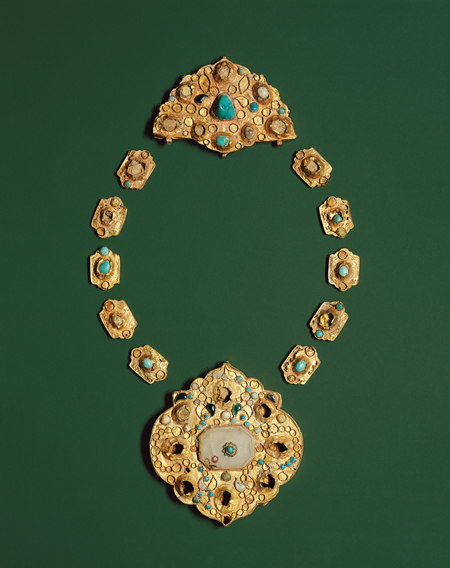In the posts I’ve made so far, I’ve talked about materials such as metal, vinyl, gemstones, and crystals, but I haven’t yet talked about glass.
After seeing an article today about an opening of a new exhibit at the Art Museum of South Texas in Corpus Christi called Glasswear: Glass in Contemporary Jewelry, it was clear that it’s time to talk glass. In this exhibit, while most of the work can be worn, the focus is on the glass as art.

This string of huge beads spans the exhibit floor. According to an article in the Caller-Times by Dr. Elizabeth E. Reese, the beads are strung on black yachting rope, with knots between each bead. The installation was meant to have 32 beads, but only 28 were used because the weight caused the rope to stretch. This is a problem that jewelry-makers face when stringing and knotting on silk, only on a much smaller scale, of course. Photo by Todd Yates, reprinted with permission of Corpus Christi Caller-Times
If you have not spent a great deal of time at bead shows or in the company of serious glass bead artists, you may not be familiar with glass beads beyond those of the artisans of Murano in Italy.
If that’s the case, you might have missed the spectacular art beads produced in borosilicate glass by Tom Boylan:

I used one of Tom's beads for this pendant. Photo by Linda Castellani
Here’s another Boylan bead, from his website http://www.tomboylan.com:

No one works magic in borosilicate glass like Tom. Photo by Martha Bouquin
or the whimsical beads produced by the incomparable Sharon Peters:
 Sharon has a skewed – in a good way – perspective on the world around her and finds ways to reproduce what she sees – real or not – in glass. One example is this egg bracelet, featuring whole eggs, sunnyside-up eggs, and a matching egg clasp. For more examples see her website at http://www.smartassglass.com. Photo by Jim Trenkle.
Sharon has a skewed – in a good way – perspective on the world around her and finds ways to reproduce what she sees – real or not – in glass. One example is this egg bracelet, featuring whole eggs, sunnyside-up eggs, and a matching egg clasp. For more examples see her website at http://www.smartassglass.com. Photo by Jim Trenkle.
Sharon and Tom work in traditional materials designed for glass beads. According to the article about the exhibit in Texas, the glass used in the collection also includes found window glass, blown glass, glass lenses, and laboratory glass, as in the work by Sandra Enterline shown here:
Here are two other breathtaking examples of what can be seen at this exhibit. Too bad I don’t have plans to be in South Texas for this; I’d love to see all of the 130 works in the exhibit.

This lighter-than-air necklace of blown Murano glass bubbles by artist Giorgio Vigna is called Gorgoglio. Photo by Todd Yates, reprinted with permission of Corpus Christi Caller-Times


